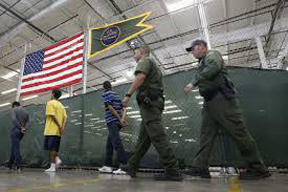 The overreaction surrounding 57,000 unaccompanied children who have come to the United States, with a population of 300 million, is not befitting of a great nation of immigrants. Indeed, some of the reaction against these children has been nothing short of disgraceful. The waving of the American flag against busloads of dazed and frightened children by residents of Murrieta in California did a great disservice to the ideals symbolized by this flag.
The overreaction surrounding 57,000 unaccompanied children who have come to the United States, with a population of 300 million, is not befitting of a great nation of immigrants. Indeed, some of the reaction against these children has been nothing short of disgraceful. The waving of the American flag against busloads of dazed and frightened children by residents of Murrieta in California did a great disservice to the ideals symbolized by this flag.
The summoning of the Texas National Guard to the border against these children, unschooled in the complexities of immigration law, is also unwarranted.
Are they going to shoot at these kids? It is further worth noting that developing countries host 80% of the world’s displaced population, while most of the anti-refugee sentiment is heard loudest in industrialized countries.
To also characterize the flow of these children to our borders as illegal migration is a canard. People escaping harm in their countries are able to seek the protection of the United States through the asylum process under the rule of law.
As a signatory to the United Nations Refugee Convention, the United Nations Convention Against Torture and other international instruments, the United States cannot ignore expressions of fear of harm and turn these children and their families away.
Section 208 of the Immigration and Nationality Act (INA), which Congress enacted in accordance with the obligations of the United States under the Refugee Convention, allows children fleeing harm to apply for asylum.
These children are not evading the border guards; rather they approach them and could hardly be charged under INA section 275 for an improper entry.
Those who argue that these children have been brought here by smugglers and coyotes may have a point, but most people use all sorts of assistance while fleeing desperately persecution, and this should not bar them from seeking asylum under INA section 208. According to Commissioner Gil Kerlikowske, these mothers and children often run towards U.S. agents, turning themselves in and seeking detainment.
There is an incident in this nation’s history that is considered a grave blemish, which should never be repeated again.
In May 1939, the St. Louis set sail for Havana, Cuba carrying mostly Jewish refugees escaping the Third Reich in Nazi Germany. Most of them planned to immigrate to the United States as they were on the waiting list for admission, and had landing certificates permitting them entry into Cuba. When Cuba refused to honor the landing certificates, the ship sailed towards Florida and the captain appealed for help.
The U.S. Coast Guard refused to allow the ship to dock in Florida and also prevented anyone from jumping for freedom into the water. When the St. Louis turned back to Europe, Belgium, the Netherlands, England and France admitted the passengers. However, within months, the Germans invaded Western Europe, and hundreds of these passengers became victims to the Nazi’s “Final Solution.”
While it is difficult to compare any other event to the horror of the Holocaust, a child who may be fleeing gang violence and certain death in San Pedro Sula, Honduras, known as the murder capital of the world, should not be turned back by the United States. The poignant story of Alejandro, only 8 years old, making it all alone to the United States in search of his mother, and also fleeing gang violence, should prompt us to find compassionate ways to find a solution rather than spit on these children.
The Trafficking Victims Protection Reauthorization Act of 2008 (TVRPA) applies to all unaccompanied minors under the age of 18.
It would be wrong for President Obama and the Congress to modify the TVRPA, and thus diminish the child’s ability to apply for asylum. Under the TVRPA, for unaccompanied minors coming from countries other than Mexico and Canada, the child must be turned to the Office of Refugee Resettlement (ORR) of the Department of Health and Human Services within 72 hours.
ORR has more expertise than border agents to help children make their asylum claims in a humane setting.
If the government wishes to remove the child, the child must still be provided a full and fair removal hearing before an Immigration Judge under INA section 240 where he or she can assert all rights available under law, including asylum and related relief, the trafficking visa and special immigrant juvenile status.
The TVRPA also incorporates a policy in favor of releasing the child or placing the child in the least restrictive and most humane detention setting as possible. While unaccompanied children from Mexico and Canada do not get the same initial protections, they too will be covered under TVRPA if the answer to any of the following three questions is “No”: 1) whether the child is unlikely to be a victim of trafficking; 2) whether the child has no fear of returning to his or her country of origin; and 3) whether the child has the ability to make to make an independent decision to withdraw his or her application for admission to the United States.
Although the protections in the TVRPA do not apply to children who are accompanied, they too along with their parents may apply for asylum after passing a credible fear test and even if they face expedited removal. Still, after the increased migration from the Central American countries, there are reports of claimants not being able to adequately express their fear of persecution at the Artesia detention facility in New Mexico.
According to a press release of the American Immigration Lawyer Association, “[w]omen are being asked to share intimate details about past persecution and violence right in front of their children because DHS has not created a safe and separate interview space,” said Karen Lucas, AILA Legislative Associate. Congress now wishes to lower the standards in the TVRPA, and if the HUMANE Act introduced by Sen. Cornyn and Rep.
Cuellar got passed, vulnerable children will be forced back to the same dangerous conditions from which they recently fled without proper screening for ascertaining the harm or the sexual abuse they may have faced and will face. Furthermore, under the HUMANE Act, victims may be further traumatized when questioned by officers who lack training and sensitivity, especially with respect to sexual assault interviewing techniques.
Clearly, the best interest of the child is paramount when addressing this humanitarian crisis, and asylum standards should not be compromised for the sake of political expediency.
Lowering safeguards and sending back children under the specious ground that they would bring diseases to the United States is repulsive. Under such perverse reasoning, lice infested concentration camp survivors may never be able to seek asylum in another country.
Fear of opening the floodgates is also not a reason for sending back people fearing harm without hearing their claim. Each asylum case must be individually judged on its own merits under the applicable law.
Rather than diminish the ability of minors to seek asylum, the United States must instead provide more funding for better access to courts and lawyers, where they can meaningfully make claims for asylum and other relief.
As the Supreme Court famously stated in a case regarding the appointment of counsel in juvenile delinquency proceedings, “The child requires the guiding hand of counsel at every step of the proceeding against him.” In re Gault, 387 U.S. 1, 37 (1967) (quoting Powell v. State of Alabama, 287 U.S. 45, 69 (1932)).
If after the child has meaningfully asserted all claims for relief, and been turned down after exhausting all appeal options, he or she may be removed from the United States in a humane manner.
Alternatively, the child can also be the subject of prosecutorial discretion if he or she meets the criteria under the Morton June 2011 memo. All children deserve protection, and Congress should be focused on strengthening protections rather than weakening them through the oxymoronic HUMANE Act.
The recent announcement by the United States to consider refugee claims of children in their own countries is salutary, but that should still not diminish their ability to seek asylum here.
The United States, as the world’s sole superpower and the lumbering giant in the backyard of countries of Central America, ought to step up and take more responsibility. It is no coincidence that the gang related violence in Central America, resulting in harm to the children fleeing, stems from the insatiable demand for illicit drugs in the United States.
Moreover, the love that bonds a parent to the child and vice versa pervades through all countries and cultures. With so many people living in the United States in an undocumented capacity and under a broken immigration system, many of these children, who are vulnerable to gang violence and poverty, would be united with parents in a more legal and orderly process if we had immigration reform.
The recent calls from GOP leaders to abolish the Deferred Action for Childhood Arrivals (DACA) program is ill-conceived and will backfire against the party in future Presidential elections. DACA has nothing to do with the flood of unaccompanied child migrants to the United States. What we need is sensible immigration reform, so that the undocumented leading productive lives in this country can legalize and have their children, vulnerable to gang violence, join them in a legal manner.
If Congress continues to obstruct immigration reform, President Obama should have the guts – and he has the authority to do so under the INA – to improve the immigration system through bold administrative fixes. It is also equally, if more important, to preserve the asylum protections so that people, especially children, fleeing harm are never turned away like those on the St. Louis.
Cyrus D. Mehta






